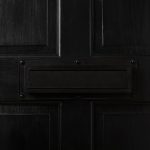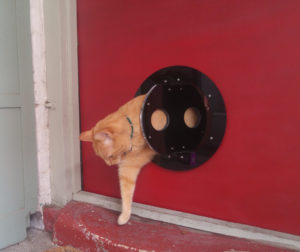Draughts

We love this dramatic black-on-black look
Draughts are part and parcel of any home. Defined as “A current of cool air in a room or other confined space”, draughts are generally unwelcome unlike a nice refreshing breeze on a warm day. In simple terms draughts find their way in uninvited and make you uncomfortable whereas a breeze is something we go in search of that makes us feel better.
A draught can come in through any of the myriad ways we make holes in our houses. Chimneys, windows, doors, letter boxes, catflaps, air bricks to name a few are not only designed to open up and allow air, animals, post and people to and fro, but many of them let in draughts when they shouldn’t, too. A properly-fitted window or external door should be completely airtight when closed – see our article on the importance of proper fitting to reach stated energy efficiency standards.
It’s not only poor fitting that interferes with airtightness. Doors and windows themselves can be slightly warped (this is why we recommend using silicone sealant to fit an Ecoflap or Petflap as it compensates for a couple of millimetres of irregular door surface), the surrounding wall can be to blame or a design can inherently allow draughts to flow in.
Draughtproofing
We’re heading into the time of year (particularly this year with our dismal wet and windy summer) when the ‘draughtproof your home for winter’ articles being to appear. In simple terms this means plugging all the gaps where draughts wind their way in to bring down the temperature of your room, prompt your boiler to fire up and generally make your home a less cosy place to be. This has an impact on your wallet too: many central heating thermostats are in the hallway, near the front door. If your letterbox is draughty or frequently jams open, draughts will blow into your hallway, bringing down the temperature and prompting the thermostat to turn on the heating, whether the rest of the house feels fine or not.
Draughtproofing is relatively simple to achieve in most problem areas. Unused chimneys can be blocked with a Chimney Sheep or similar, doors can be covered with a curtain and floor-level gaps blocked with a sausage-style draught excluder, and clear gaps at the sides of windows can be filled with spray sealant.
Your letter box is another gap easily draughtproofed. Our Ecoflap letter box draught excluder goes on the inside of your door and presents a slightly larger surface area to draughts, whichever direction they’re coming from. This means the flap is always pressed more firmly against the frame by the airflow, sealing it and leaving draughts outside, together with rain and anything else the weather wants to throw at us. Our draughtproof Petflap works on exactly the same principle, and both units can be fitted to a fence or through a wall, as well as to a door.
Draughtproof letterboxes

This letterbox will let in draughts all day long
Why aren’t all letterboxes draughtproof? It’s down to design. Other letter box draught excluders function by presenting a barrier to incoming deliveries, often a brush or spring-loaded flap. If post struggles to get through these barriers it’s left sticking out at both sides of the door, allowing a fair old draught to whistle through, all day long if no-one’s in the house during the day. The Ecoflap’s clever balanced cut means that although it will stay shut in the teeth of a 100mph wind (yup, we’ve had it tested), it opens with the merest touch, so a leaflet will slide through as easily as a weekend paper or Amazon box.
Not only does the Ecoflap present no barrier to deliveries, but it returns itself to the shut position every single time and gets on with its job of keeping draughts out of your house. In North America many people order it to keep that expensive air-conditioned air in during the sweltering summer months, so whatever temperature you want your house to be, whatever the season, you can rely on the robust Ecoflap letter box draught excluder.






